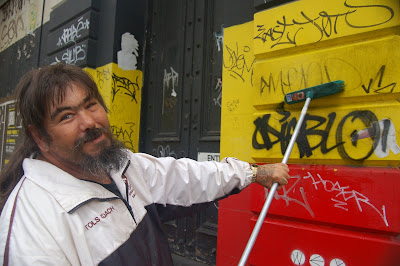Founded in 1973, the Victorian Aboriginal Health Service (VAHS) moved from 229 to 136 Gertrude Street in 1976 after signing a 99-year lease for the premises with the State Government. Many Aboriginal People were dying in the streets due to prolonged oppression and denial of basic human services. As staff worked without pay due to lack of funding, Aboriginal Elders including Alma Thorpe and Dr. Bruce McGuinness pioneered to establish critical community controlled preventative health care to ensure the survival of Aboriginal Communities in Fitzroy and nationwide.
In 1991, VAHS lodged an official complaint to the Minister of Police and Aboriginal Affairs regarding ‘ongoing brutalization’ of Aboriginal people in the community, which continues to this day. Since the official opening of the new VAHS at 186 Nicholson Street in 1993, the old Aboriginal Health Service in Gertrude Street has been left abandoned and derelict for 15 years. Mission Australia recently won a tender to redevelop the site into a ‘bush tucker’ restaurant where Kooris would be trained to ‘serve’ as waiters under the Mission banner. How much more insulting and low could the system go in trying to extinguish Victoria’s history of Aboriginal struggles for self-determination and human rights? With no Community Cultural Center in the vicinity of Fitzroy, the local Aboriginal community want to see this site resurrected as a crucial Community Meeting Place for healing, traditional culture, and in honor of the many brave Aboriginal Ancestors and Elders who fought for so long to live and die with dignity.
Following the National Weekend of Action (Nov 16 –17) members of the Fitzroy and Victorian Indigenous Communities and supporters will stage a vigil outside 136 Gertrude Street to bring overdue attention to these injustices at 07’ Election time. Each sundown the Sacred Fire Traditional Smoking Ceremony is being reignited across the road in Atherton Gardens for community healing and to pay respect to all who have not lived to see the struggle for justice end.

* Statistics published by the Australian Human Rights and Equal Opportunity Commission on Indigenous child abuse show Victoria has the worse track record of abuse, with nearly 5 times more cases than anywhere else in Australia.
* The Australian Bureau of Statistics recent census revealed that the Victorian Koori population suffers the highest rates of recent and chronic illness in the country.
* The 2004 United Nations Human Development Report exposes that Aboriginal People in Australia have the second worst quality of life on the planet. With China ranking last and Australia’s general population coming fourth, the UN study measured areas of education attainment, life expectancy and median income levels.
* Another recent report by the World Health Organisation states that Indigenous Health in Australia is 100 years behind the rest of the whole population.
* Such shameful genocide continues as the Australian government invades Aboriginal communities in the NT, intervenes by force in Aboriginal affairs country-wide, and refuses to sign the UN Declaration on Indigenous People’s Rights because of the word “self-determination.”
United Nations Convention on the Prevention and Punishment of the Crime of Genocide
*Article II...genocide means any of the following acts committed with intent to destroy, in whole or in part, a national, ethnical, racial or religious group, as such :
(a) Killing members of the group;
(b) Causing serious bodily or mental harm to members of the group;
(c) Deliberately inflicting on the group conditions of life calculated to bring about its physical destruction in whole or in part;
(d) Imposing measures intended to prevent births within the group;
(e) Forcibly transferring children of the group to another group
For further information email; robbiethorpe@gmail.com

